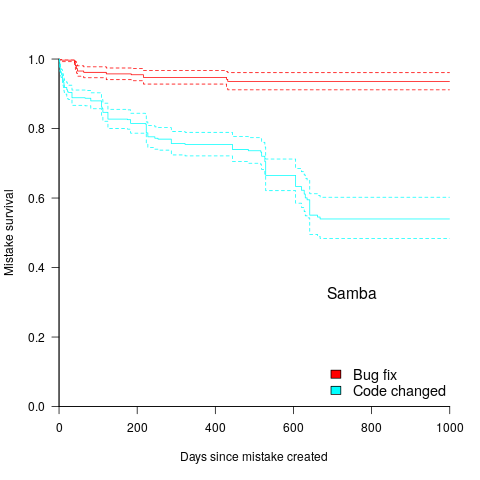Derek Jones from The Shape of Code
Changing two words in the Wikipedia description of Ecology gives “… the study of the relationships between software systems, including humans, and their physical environment”; where physical environment might be taken to include the hardware on which software runs and the hardware whose behavior it controls.
What do ecologists study? Wikipedia lists the following main areas; everything after the first sentence, in each bullet point, is my wording:
- Life processes, antifragility, interactions, and adaptations.
Software system life processes include its initial creation, devops, end-user training, and the sales and marketing process.
While antifragility is much talked about, it is something of a niche research topic. Those involved in the implementations of safety-critical systems seem to be the only people willing to invest the money needed to attempt to build antifragile software. Is N-version programming the poster child for antifragile system software?
Interaction with a widely used software system will have an influence on the path taken by cultures within associated microdomains. Users adapt their behavior to the affordance offered by a software system.
A successful software system (and even unsuccessful ones) will exist in multiple forms, i.e., there will be a product line. Software variability and product lines is an active research area.
- The movement of materials and energy through living communities.
Is money the primary unit of energy in software ecosystems? Developer time is needed to create software, which may be paid for or donated for free. Supporting a software system, or rather supporting the needs of the users of the software is often motivated by a salary, although a few do provide limited free support.
What is the energy that users of software provide? Money sits at the root; user attention sells product.
- The successional development of ecosystems (“… succession is the process of change in the species structure of an ecological community over time.”)
Before the Internet, monthly computing magazines used to run features on the changing landscape of the computer world. These days, we have blogs/podcasts telling us about the latest product release/update. The Ecosystems chapter of my software engineering book has sections on evolution and lifespan, but the material is sparse.
Over the longer term, this issue is the subject studied by historians of computing.
Moore’s law is probably the most famous computing example of succession.
- Cooperation, competition, and predation within and between species.
These issues are primarily discussed by those interested in the business side of software. Developers like to brag about how their language/editor/operating system/etc is better than the rest, but there is no substance to the discussion.
Governments have an interest in encouraging effective competition, and have enacted various antitrust laws.
- The abundance, biomass, and distribution of organisms in the context of the environment.
These are the issues where marketing departments invest in trying to shift the distribution in their company’s favour, and venture capitalists spend their time trying to spot an opportunity (and there is the clickbait of language popularity articles).
The abundance of tools/products, in an ecosystem, does not appear to deter people creating new variants (suggesting that perhaps ambition or dreams are the unit of energy for software ecosystems).
- Patterns of biodiversity and its effect on ecosystem processes.
Various kinds of diversity are important for biological systems, e.g., the mutual dependencies between different species in a food chain, and genetic diversity as a resource that provides a mechanism for species to adapt to changes in their environment.
It’s currently fashionable to be in favour of diversity. Diversity is so popular in ecology that a 2003 review listed 24 metrics for calculating it. I’m sure there are more now.
Diversity is not necessarily desired in software systems, e.g., the runtime behavior of source code should not depend on the compiler used (there are invariably edge cases where it does), and users want different editor command to be consistently similar.
Open source has helped to reduce diversity for some applications (by reducing the sales volume of a myriad of commercial offerings). However, the availability of source code significantly reduces the cost/time needed to create close variants. The 5,000+ different cryptocurrencies suggest that the associated software is diverse, but the rapid evolution of this ecosystem has driven developers to base their code on the source used to implement earlier currencies.
Governments encourage competitive commercial ecosystems because competition discourages companies charging high prices for their products, just because they can. Being competitive requires having products that differ from other vendors in a desirable way, which generates diversity.

 , with the variance being similar to that found
, with the variance being similar to that found  ). The
). The  (based on benchmark performance, i.e.,
(based on benchmark performance, i.e.,  (what the hardware is theoretically capable of, which is sometimes more than twice
(what the hardware is theoretically capable of, which is sometimes more than twice 
 and
and  parameters, which I assume is the result of bespoke systems having the memory capacity to handle more parameters (
parameters, which I assume is the result of bespoke systems having the memory capacity to handle more parameters (
 .
. is the cost of fixing the mistake in the code (including testing etc), and
is the cost of fixing the mistake in the code (including testing etc), and  is the cost of finding the mistake in the code based on a customer fault report (i.e., the sum on the right is the total cost of fixing a fault reported by a customer).
is the cost of finding the mistake in the code based on a customer fault report (i.e., the sum on the right is the total cost of fixing a fault reported by a customer). , e.g., a developer reading the code for another reason, or flagged by a static analysis tool.
, e.g., a developer reading the code for another reason, or flagged by a static analysis tool. be the likelihood that the coding mistake ceases to exist in the next unit of time.
be the likelihood that the coding mistake ceases to exist in the next unit of time. be the likelihood that a fault is reported in the next time unit.
be the likelihood that a fault is reported in the next time unit.
 , is slightly less than one.
, is slightly less than one.

 ?
? are likely to change as a system evolves, e.g., high code turnover during early releases that slows as the system matures. The value of
are likely to change as a system evolves, e.g., high code turnover during early releases that slows as the system matures. The value of 

 .
.